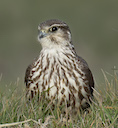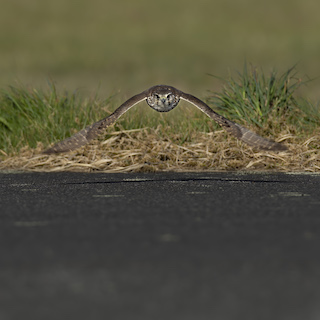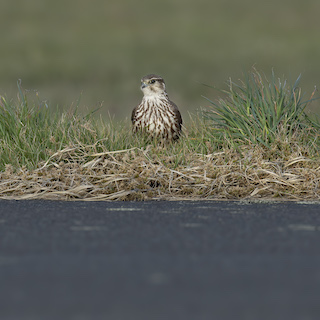 The Merlin is our smallest bird of prey, but it makes up for its size with lots of grit and steely determination.
The Merlin is our smallest bird of prey, but it makes up for its size with lots of grit and steely determination.
Photo: © Richard Birchett
Scientific name: Falco columbarius
Other common names: Pigeon Hawk (North America), Eurasian Merlin (the common name of the subspecies found in Britain), Moor Hawk (Britain, late nineteenth century)
UK conservation status: Red. Protected under Schedule 1 of the the Wildlife and Countryside Act 1981.
What to look for:
• Colouring and appearance: Small bird of prey, fairly stocky. There are colour variations depending on season and subspecies. Males have a blue- to silver-grey back and streaked buff to orange underparts. Females have brown to grey upperparts and brown-spotted white underparts. Both sexes have black wing feathers and banded tail feathers, with black tip and thin white band at the tail-end.
• Size: Wingspan, 50 to 62 cm; length 25 to 30 cm. Females are a little larger than the males.
• Where: Coast, open country including moors and heaths.
• Call: Merlins are generally silent, but will make a ‘kee-kee-kee’ alarm call
 It may be the smallest of our birds of prey, but a Merlin is an exhilarating sight as it dashes by on its swiftly beating wings, or soars along in a glide, wings held close to its sides. Merlins are highly skilled hunters, chasing their prey down by flying fast and close to the ground. They mainly eat small birds, which are usually captured on the wing, but Merlins are also known to ambush their prey using trees and bushes as camouflage. They can be opportunistic, chasing after prey that has been flushed out of cover by other predators. These varying hunting tactics place Merlins among the most versatile predators of their raptor cousins.
It may be the smallest of our birds of prey, but a Merlin is an exhilarating sight as it dashes by on its swiftly beating wings, or soars along in a glide, wings held close to its sides. Merlins are highly skilled hunters, chasing their prey down by flying fast and close to the ground. They mainly eat small birds, which are usually captured on the wing, but Merlins are also known to ambush their prey using trees and bushes as camouflage. They can be opportunistic, chasing after prey that has been flushed out of cover by other predators. These varying hunting tactics place Merlins among the most versatile predators of their raptor cousins.
Numbers are probably increasing here (most recent count, 900 to 1500 breeding pairs). This represents a recovery from a previous historical decline towards the end of the last century – as an apex predator, Merlins were among the most affected by the misuse of pesticides in that period. The species remains Red-listed in the UK.
The primary Eurasian Merlin breeding populations are further north, including Iceland. The British Isles lie in the south of their range, and breeding pairs here can be found in high moorland. In the UK, Merlins are predominantly ground-nesting, hiding their nests among the undergrowth. This contrasts with European populations, which nest in trees. UK population breeding habits have been changing since the 1970s, however, and some birds are now nesting in trees close to the edges of conifer stands. This is another tick for the versatility of Merlins as they adapt to changes in their breeding habitats.
 Ground nests are shallow, built of twigs and vegetation. The female lays up to five eggs, and it is she who is primarily on incubation duty, though the male will help out. He, however, focusses on finding food for his mate and their young. The young fledge after about 30 days, and are fully independent 30 days later. In winter, birds move to open country inland and to the coast, and numbers are increased by birds migrating from further north. They roost in groups, often sharing space with Hen Harriers.
Ground nests are shallow, built of twigs and vegetation. The female lays up to five eggs, and it is she who is primarily on incubation duty, though the male will help out. He, however, focusses on finding food for his mate and their young. The young fledge after about 30 days, and are fully independent 30 days later. In winter, birds move to open country inland and to the coast, and numbers are increased by birds migrating from further north. They roost in groups, often sharing space with Hen Harriers.
Did you know…?
… The genus name Falco is from the Latin for sickle, a nod to the curved claws of birds in this group. The species name columbarius is also Latin, meaning of doves.
… Merlins were used in mediaeval falconry. The Book of St Albans listed the species as “the falcon for a lady”.
More information and references:
Svensson, L., Mullarney, K., Zetterstrom, D.,1986. Collins Bird Guide, second edition (translated by Christie, D., Svensson, L.). HarperCollins, London.
Published: May 2020
Author: Amanda Scott
Photos: Richard Birchett (website and YouTube page)
